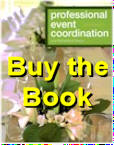|
Event Management: Architecture,
Engineering, or Project Management?
Published in Mark Sonder
Productions Ezine, Summer 2006
Janet
Landey, CSEP, of Party Design Pty Ltd in Johannesburg, South Africa, contends
that event designers and organizers need to consider themselves as event
architects instead to better reflect their ability to help clients achieve their
strategic goals if brought to the table early.
Futurist
Alvin Toffler suggested, indirectly, that we should think of ourselves as
“experiential engineers” because what we are creating is an experience rather
than simply an environment or an activity, which will ultimately provide more
economic and emotional value to the event consumer.
William
J. O’Toole of Event Project Management System Pty Ltd in Sydney, Australia,
champions the adoption of project management techniques for the effective
development and production of events, resulting in improved efficiency, safety,
and sustainability.
It is
interesting that two of these three occupations are used as analogies in
sociologist Eliot Freidson’s book Professionalism, the third logic (2001,
The University of Chicago Press) as he discusses the forms of knowledge —
descriptive, prescriptive and artistic — and the authority claims each type
confers on a profession (or, to be more precise, confers status as a
profession). Descriptive forms, which include science and scholarship, claim
technical authority; prescriptive forms, which include the social norms, claim
moral authority; and the arts claim aesthetic authority.
The very
title of Joe Jeff Goldblatt’s pioneering book Special Events, the Art and
Science of Celebration (1990, Van Nostrand Reinhold) captures the duality of
the knowledge required of an event management professional. And as one delves
into the book one realizes that, in actuality, Freidson’s knowledge triad must
be present to ensure that the empirical, artistic, and ethos are incorporated
into the deliverables of event management.
There is
no doubt that all three occupational tasks are required for event management.
One must be an architect, interpreting the client’s desires and objectives to
design the concept or vision for the event, but this design process must have a
strong foundation in the practicalities of event production (engineering and
project management). When brought to the table in the earliest stages of event
inception, the event architect can shape the design to the strategic goals as
they are being developed, and do so within the realities of the resources
available.
One must
be an experiential engineer, interpreting that vision and shaping that design
into a structural plan capable of being implemented. Like the steel, bricks, and
mortar used to build the building the architect has designed, the event engineer
selects and sequences the proper program components and elements that will
deliver the experience desired according to the resources available. As event
project manager, the goods, services, and personnel are procured and the
logistics of implementing the plan are devised and supervised. These three
aspects of event management — aesthetic, structural and logistical — may
represent a division of labor or may be facets of the work done by an individual
practitioner.
Architecture, engineering, and project management all employ the technical or
scientific types of knowledge. The architect, however, is the only one that
gains status through the aesthetic arena, and a large part of that
“professional” status comes, according to Freidson, as a result of its singular
area of practice — buildings. Engineering and project management are disciplines
that are practiced in many different industries, and the tasks they perform vary
according to the specialized industry. This perception of status is based on the
public’s ability to recognize the architect’s distinct realm of practice and the
artistic skills associated with it.
I think
Janet Landey has the right idea. It is in the realm of aesthetic and strategic
authority that event management will gain its status as a profession rather than
an occupation or, worse, a commoditized job, no matter how skilled the worker
may be or need to be.

Consider,
for example, the Opening Ceremonies of the 2006 Winter Olympic Games in Turin,
Italy. The three-hour spectacle featured tradition, innovation, pageantry, and
countless cultural icons celebrating the history of the Games and Italy's rich
contributions to theater, art, music, fashion, style, and sports heroes
throughout the centuries. The strategic and aesthetic challenges were to
integrate the Torino Games’ motto “Passion Lives Here,” highlight and promote
“all things Italian,” showcase the city of Turin and the assets of the Piedmont
region, meet the IOC specifications for the formal ceremonies, and create a
spectacle for worldwide television coverage.
The
conceptual centerpiece, the single creative element brought together the
different protocol and spectacle segments of the production, was the Sparks of
Passion, eight inline skaters that wore helmets that spewed two-meter long
flames and raced through dancers and around the stage at speeds of up to 70
kilometers per hour. This iconic element, meant to symbolize the energy,
passion, and speed of the Olympic athletes and the Italians, helped transition
the program comprised of six mandatory ceremonial and eight entertainment
segments. Rhythm, passion, and speed were infused throughout the program, from
the extensive use of innovative pyrotechnics to the disco music that helped
maintain the tempo of the athletes’ entry during the Parade of Nations to the
Sbandieratori, a complex flag-waving ceremony that began in medieval Italy as a
martial art and weapons drill for standard bearers.
Every
aspect of the program required significant technical, scientific, and logistical
expertise, but it was the artistic vision that drove the production and the
strategic objectives that directed the ceremonial and entertainment choices
made. This is what sets the event “architect” apart from the event “planner” and
elevates this to the status of a profession.
Back
to Publications


|




